MIS770 - TechnoMart Industries Employee Satisfaction Survey Report
VerifiedAdded on 2023/06/07
|10
|2187
|346
Report
AI Summary
This report presents an analysis of the TechnoMart employee satisfaction survey, involving 400 randomly selected participants. Utilizing both descriptive and inferential statistics, the study reveals key findings regarding employee working hours, union membership influence, and job satisfaction levels. The average working hours were found to be approximately 45.43, with no significant difference in working hours between union and non-union members. However, a bias was observed in the positions held by union and non-union employees, with non-union members seemingly favored. Job satisfaction levels also varied slightly, with a larger percentage of non-unionized employees expressing higher satisfaction. Further analysis identified education years, working years, employment years, and gender as significant predictors of pre-tax income. The report also addresses concerns regarding workforce aging and union claims, validating the union's assertion that their members demonstrate greater loyalty to the organization. Finally, the report provides recommendations regarding future survey sample sizes to accurately estimate the scale of workers running immoderate hours. Desklib offers a wide range of solved assignments and resources for students.
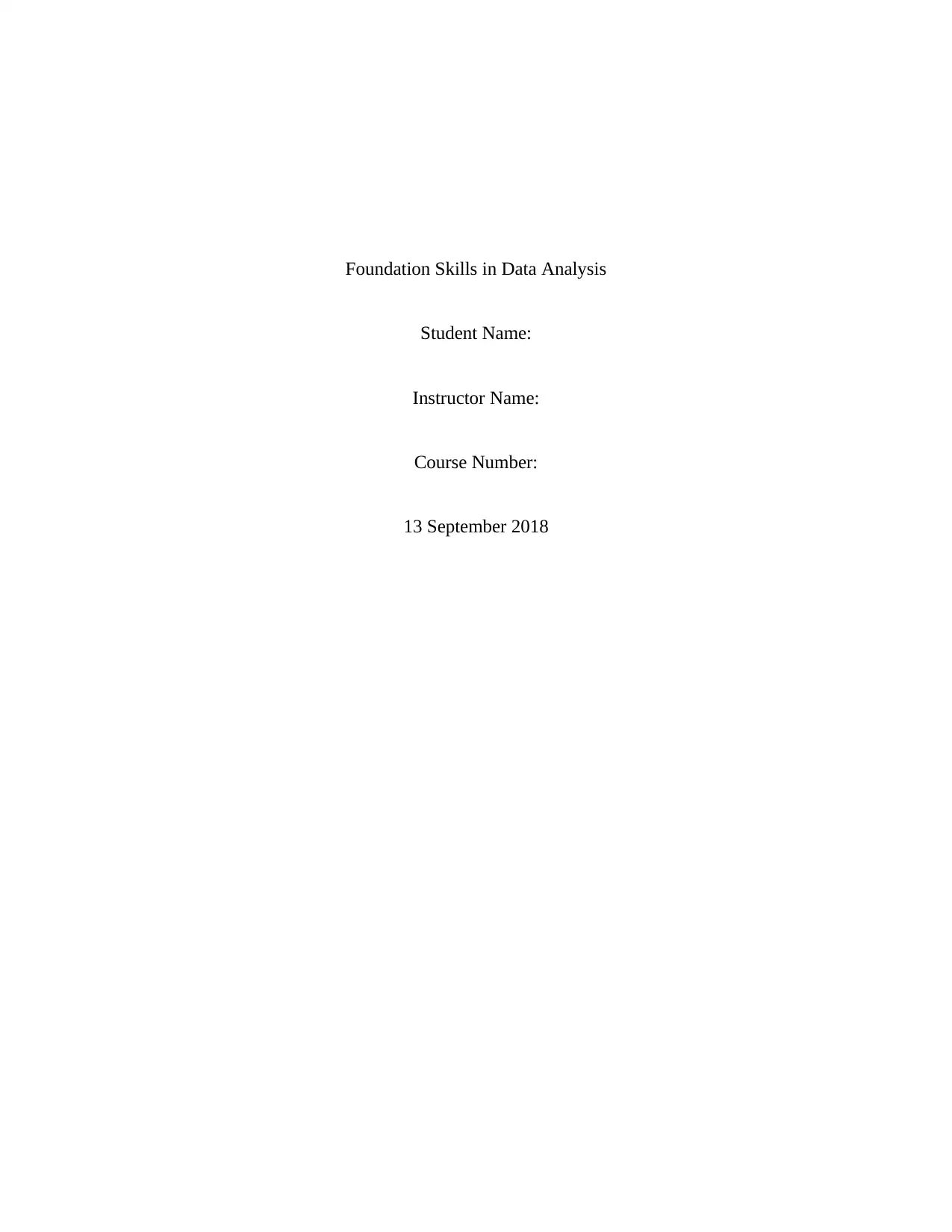
Foundation Skills in Data Analysis
Student Name:
Instructor Name:
Course Number:
13 September 2018
Student Name:
Instructor Name:
Course Number:
13 September 2018
Paraphrase This Document
Need a fresh take? Get an instant paraphrase of this document with our AI Paraphraser
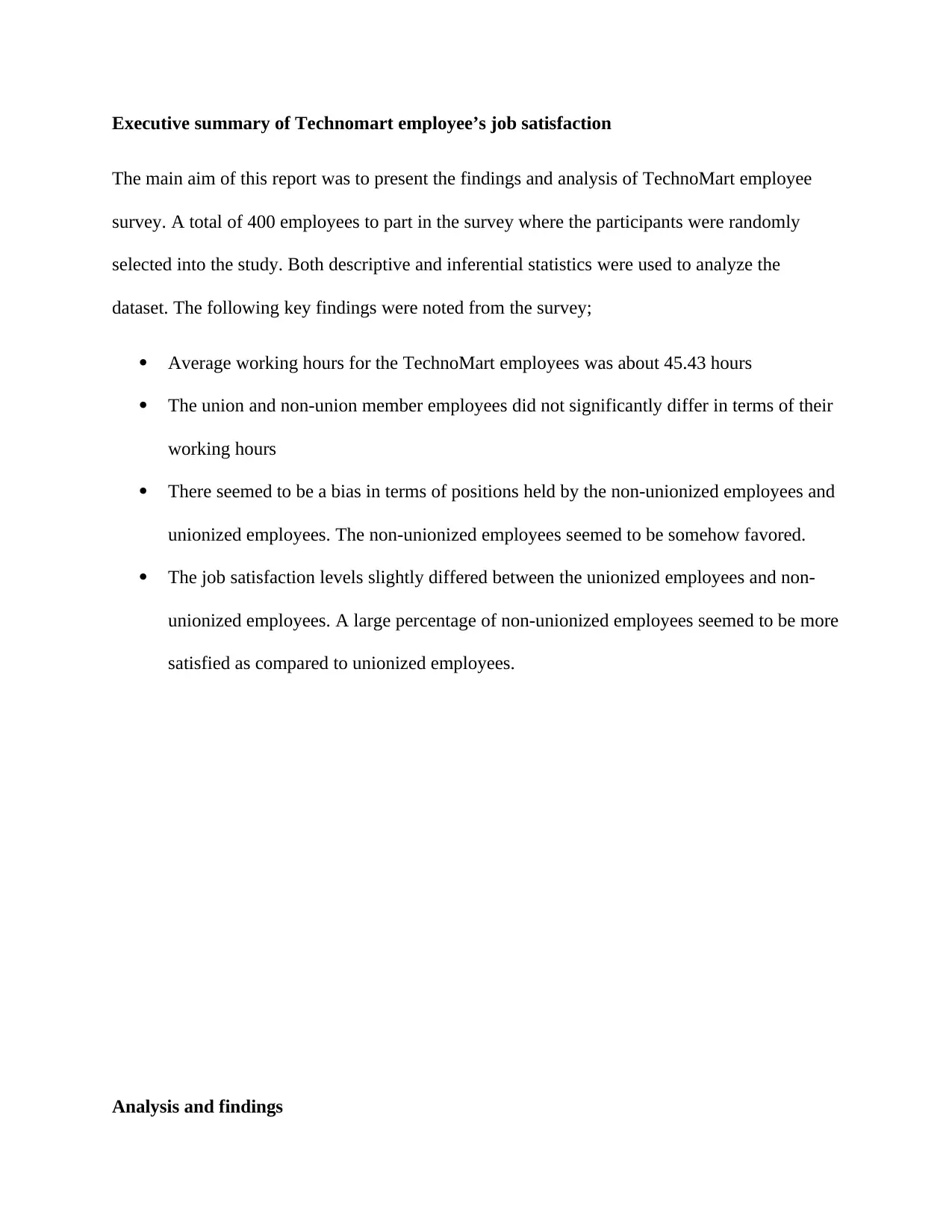
Executive summary of Technomart employee’s job satisfaction
The main aim of this report was to present the findings and analysis of TechnoMart employee
survey. A total of 400 employees to part in the survey where the participants were randomly
selected into the study. Both descriptive and inferential statistics were used to analyze the
dataset. The following key findings were noted from the survey;
Average working hours for the TechnoMart employees was about 45.43 hours
The union and non-union member employees did not significantly differ in terms of their
working hours
There seemed to be a bias in terms of positions held by the non-unionized employees and
unionized employees. The non-unionized employees seemed to be somehow favored.
The job satisfaction levels slightly differed between the unionized employees and non-
unionized employees. A large percentage of non-unionized employees seemed to be more
satisfied as compared to unionized employees.
Analysis and findings
The main aim of this report was to present the findings and analysis of TechnoMart employee
survey. A total of 400 employees to part in the survey where the participants were randomly
selected into the study. Both descriptive and inferential statistics were used to analyze the
dataset. The following key findings were noted from the survey;
Average working hours for the TechnoMart employees was about 45.43 hours
The union and non-union member employees did not significantly differ in terms of their
working hours
There seemed to be a bias in terms of positions held by the non-unionized employees and
unionized employees. The non-unionized employees seemed to be somehow favored.
The job satisfaction levels slightly differed between the unionized employees and non-
unionized employees. A large percentage of non-unionized employees seemed to be more
satisfied as compared to unionized employees.
Analysis and findings
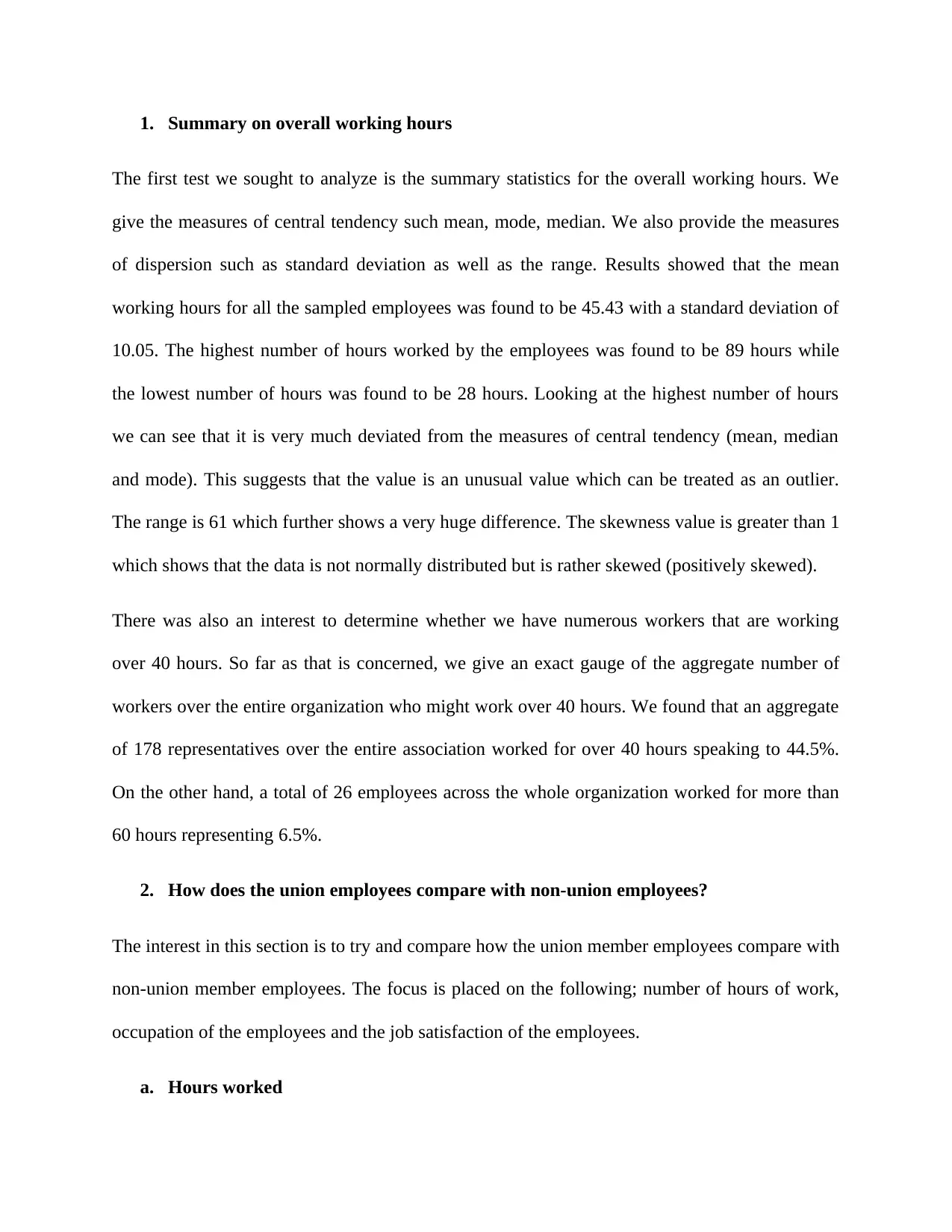
1. Summary on overall working hours
The first test we sought to analyze is the summary statistics for the overall working hours. We
give the measures of central tendency such mean, mode, median. We also provide the measures
of dispersion such as standard deviation as well as the range. Results showed that the mean
working hours for all the sampled employees was found to be 45.43 with a standard deviation of
10.05. The highest number of hours worked by the employees was found to be 89 hours while
the lowest number of hours was found to be 28 hours. Looking at the highest number of hours
we can see that it is very much deviated from the measures of central tendency (mean, median
and mode). This suggests that the value is an unusual value which can be treated as an outlier.
The range is 61 which further shows a very huge difference. The skewness value is greater than 1
which shows that the data is not normally distributed but is rather skewed (positively skewed).
There was also an interest to determine whether we have numerous workers that are working
over 40 hours. So far as that is concerned, we give an exact gauge of the aggregate number of
workers over the entire organization who might work over 40 hours. We found that an aggregate
of 178 representatives over the entire association worked for over 40 hours speaking to 44.5%.
On the other hand, a total of 26 employees across the whole organization worked for more than
60 hours representing 6.5%.
2. How does the union employees compare with non-union employees?
The interest in this section is to try and compare how the union member employees compare with
non-union member employees. The focus is placed on the following; number of hours of work,
occupation of the employees and the job satisfaction of the employees.
a. Hours worked
The first test we sought to analyze is the summary statistics for the overall working hours. We
give the measures of central tendency such mean, mode, median. We also provide the measures
of dispersion such as standard deviation as well as the range. Results showed that the mean
working hours for all the sampled employees was found to be 45.43 with a standard deviation of
10.05. The highest number of hours worked by the employees was found to be 89 hours while
the lowest number of hours was found to be 28 hours. Looking at the highest number of hours
we can see that it is very much deviated from the measures of central tendency (mean, median
and mode). This suggests that the value is an unusual value which can be treated as an outlier.
The range is 61 which further shows a very huge difference. The skewness value is greater than 1
which shows that the data is not normally distributed but is rather skewed (positively skewed).
There was also an interest to determine whether we have numerous workers that are working
over 40 hours. So far as that is concerned, we give an exact gauge of the aggregate number of
workers over the entire organization who might work over 40 hours. We found that an aggregate
of 178 representatives over the entire association worked for over 40 hours speaking to 44.5%.
On the other hand, a total of 26 employees across the whole organization worked for more than
60 hours representing 6.5%.
2. How does the union employees compare with non-union employees?
The interest in this section is to try and compare how the union member employees compare with
non-union member employees. The focus is placed on the following; number of hours of work,
occupation of the employees and the job satisfaction of the employees.
a. Hours worked
⊘ This is a preview!⊘
Do you want full access?
Subscribe today to unlock all pages.

Trusted by 1+ million students worldwide
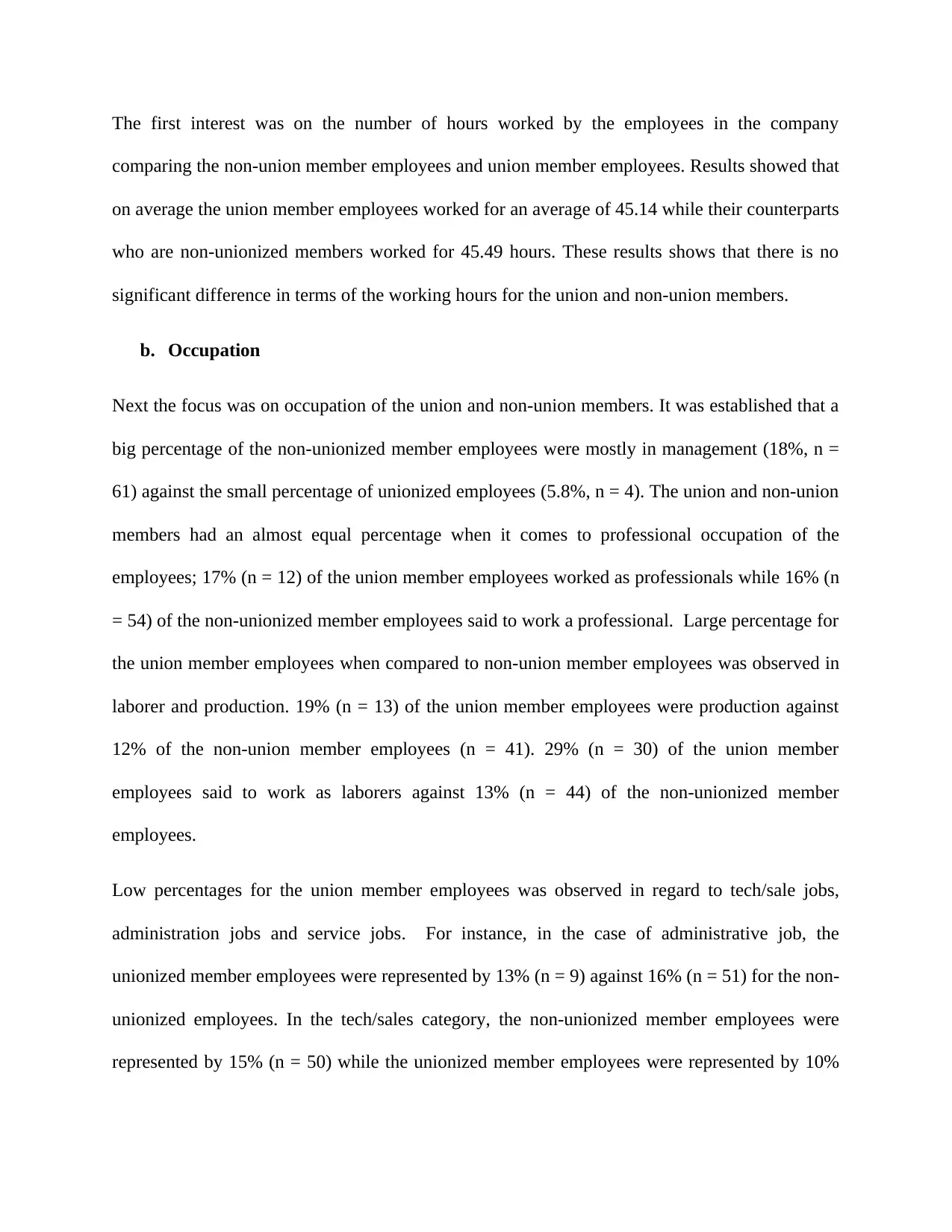
The first interest was on the number of hours worked by the employees in the company
comparing the non-union member employees and union member employees. Results showed that
on average the union member employees worked for an average of 45.14 while their counterparts
who are non-unionized members worked for 45.49 hours. These results shows that there is no
significant difference in terms of the working hours for the union and non-union members.
b. Occupation
Next the focus was on occupation of the union and non-union members. It was established that a
big percentage of the non-unionized member employees were mostly in management (18%, n =
61) against the small percentage of unionized employees (5.8%, n = 4). The union and non-union
members had an almost equal percentage when it comes to professional occupation of the
employees; 17% (n = 12) of the union member employees worked as professionals while 16% (n
= 54) of the non-unionized member employees said to work a professional. Large percentage for
the union member employees when compared to non-union member employees was observed in
laborer and production. 19% (n = 13) of the union member employees were production against
12% of the non-union member employees (n = 41). 29% (n = 30) of the union member
employees said to work as laborers against 13% (n = 44) of the non-unionized member
employees.
Low percentages for the union member employees was observed in regard to tech/sale jobs,
administration jobs and service jobs. For instance, in the case of administrative job, the
unionized member employees were represented by 13% (n = 9) against 16% (n = 51) for the non-
unionized employees. In the tech/sales category, the non-unionized member employees were
represented by 15% (n = 50) while the unionized member employees were represented by 10%
comparing the non-union member employees and union member employees. Results showed that
on average the union member employees worked for an average of 45.14 while their counterparts
who are non-unionized members worked for 45.49 hours. These results shows that there is no
significant difference in terms of the working hours for the union and non-union members.
b. Occupation
Next the focus was on occupation of the union and non-union members. It was established that a
big percentage of the non-unionized member employees were mostly in management (18%, n =
61) against the small percentage of unionized employees (5.8%, n = 4). The union and non-union
members had an almost equal percentage when it comes to professional occupation of the
employees; 17% (n = 12) of the union member employees worked as professionals while 16% (n
= 54) of the non-unionized member employees said to work a professional. Large percentage for
the union member employees when compared to non-union member employees was observed in
laborer and production. 19% (n = 13) of the union member employees were production against
12% of the non-union member employees (n = 41). 29% (n = 30) of the union member
employees said to work as laborers against 13% (n = 44) of the non-unionized member
employees.
Low percentages for the union member employees was observed in regard to tech/sale jobs,
administration jobs and service jobs. For instance, in the case of administrative job, the
unionized member employees were represented by 13% (n = 9) against 16% (n = 51) for the non-
unionized employees. In the tech/sales category, the non-unionized member employees were
represented by 15% (n = 50) while the unionized member employees were represented by 10%
Paraphrase This Document
Need a fresh take? Get an instant paraphrase of this document with our AI Paraphraser
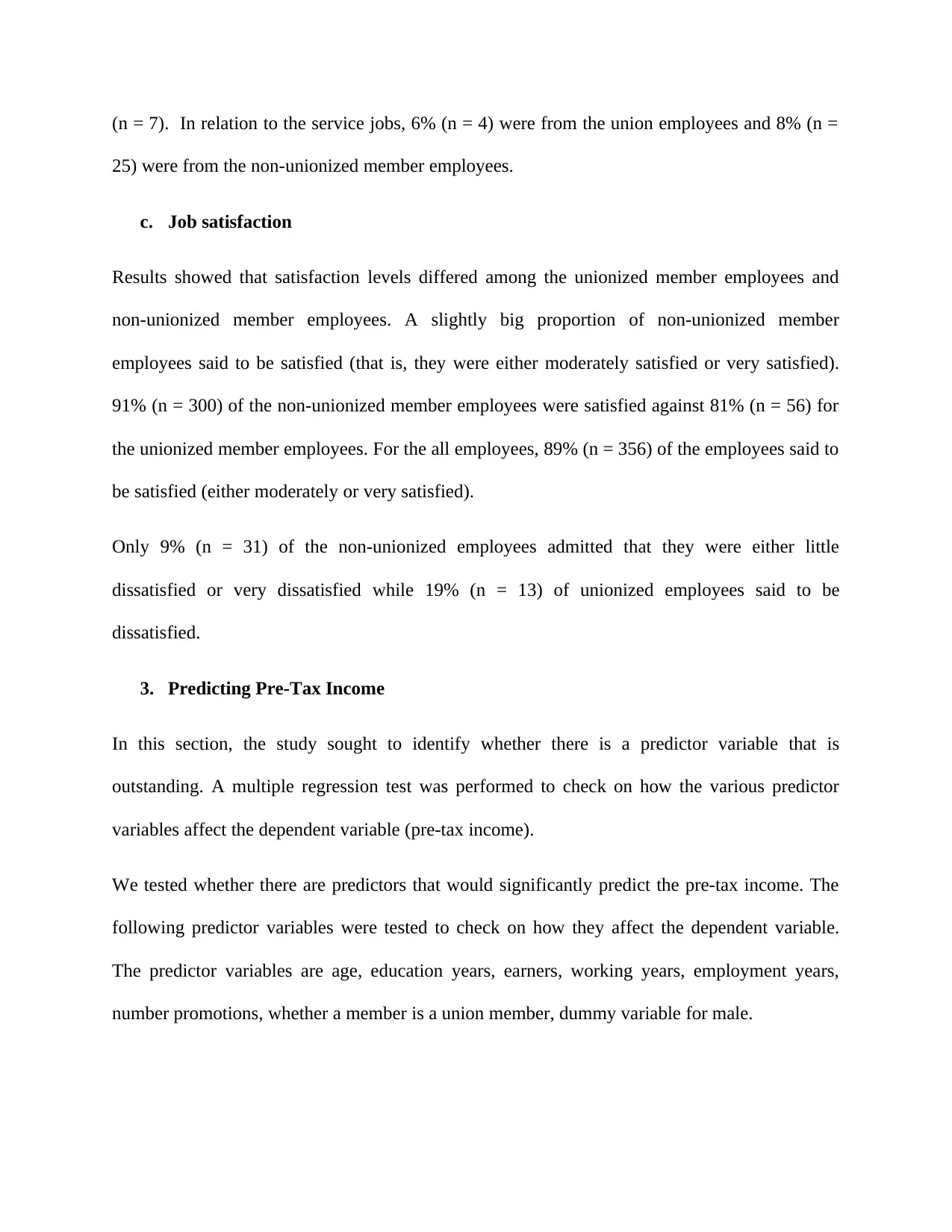
(n = 7). In relation to the service jobs, 6% (n = 4) were from the union employees and 8% (n =
25) were from the non-unionized member employees.
c. Job satisfaction
Results showed that satisfaction levels differed among the unionized member employees and
non-unionized member employees. A slightly big proportion of non-unionized member
employees said to be satisfied (that is, they were either moderately satisfied or very satisfied).
91% (n = 300) of the non-unionized member employees were satisfied against 81% (n = 56) for
the unionized member employees. For the all employees, 89% (n = 356) of the employees said to
be satisfied (either moderately or very satisfied).
Only 9% (n = 31) of the non-unionized employees admitted that they were either little
dissatisfied or very dissatisfied while 19% (n = 13) of unionized employees said to be
dissatisfied.
3. Predicting Pre-Tax Income
In this section, the study sought to identify whether there is a predictor variable that is
outstanding. A multiple regression test was performed to check on how the various predictor
variables affect the dependent variable (pre-tax income).
We tested whether there are predictors that would significantly predict the pre-tax income. The
following predictor variables were tested to check on how they affect the dependent variable.
The predictor variables are age, education years, earners, working years, employment years,
number promotions, whether a member is a union member, dummy variable for male.
25) were from the non-unionized member employees.
c. Job satisfaction
Results showed that satisfaction levels differed among the unionized member employees and
non-unionized member employees. A slightly big proportion of non-unionized member
employees said to be satisfied (that is, they were either moderately satisfied or very satisfied).
91% (n = 300) of the non-unionized member employees were satisfied against 81% (n = 56) for
the unionized member employees. For the all employees, 89% (n = 356) of the employees said to
be satisfied (either moderately or very satisfied).
Only 9% (n = 31) of the non-unionized employees admitted that they were either little
dissatisfied or very dissatisfied while 19% (n = 13) of unionized employees said to be
dissatisfied.
3. Predicting Pre-Tax Income
In this section, the study sought to identify whether there is a predictor variable that is
outstanding. A multiple regression test was performed to check on how the various predictor
variables affect the dependent variable (pre-tax income).
We tested whether there are predictors that would significantly predict the pre-tax income. The
following predictor variables were tested to check on how they affect the dependent variable.
The predictor variables are age, education years, earners, working years, employment years,
number promotions, whether a member is a union member, dummy variable for male.
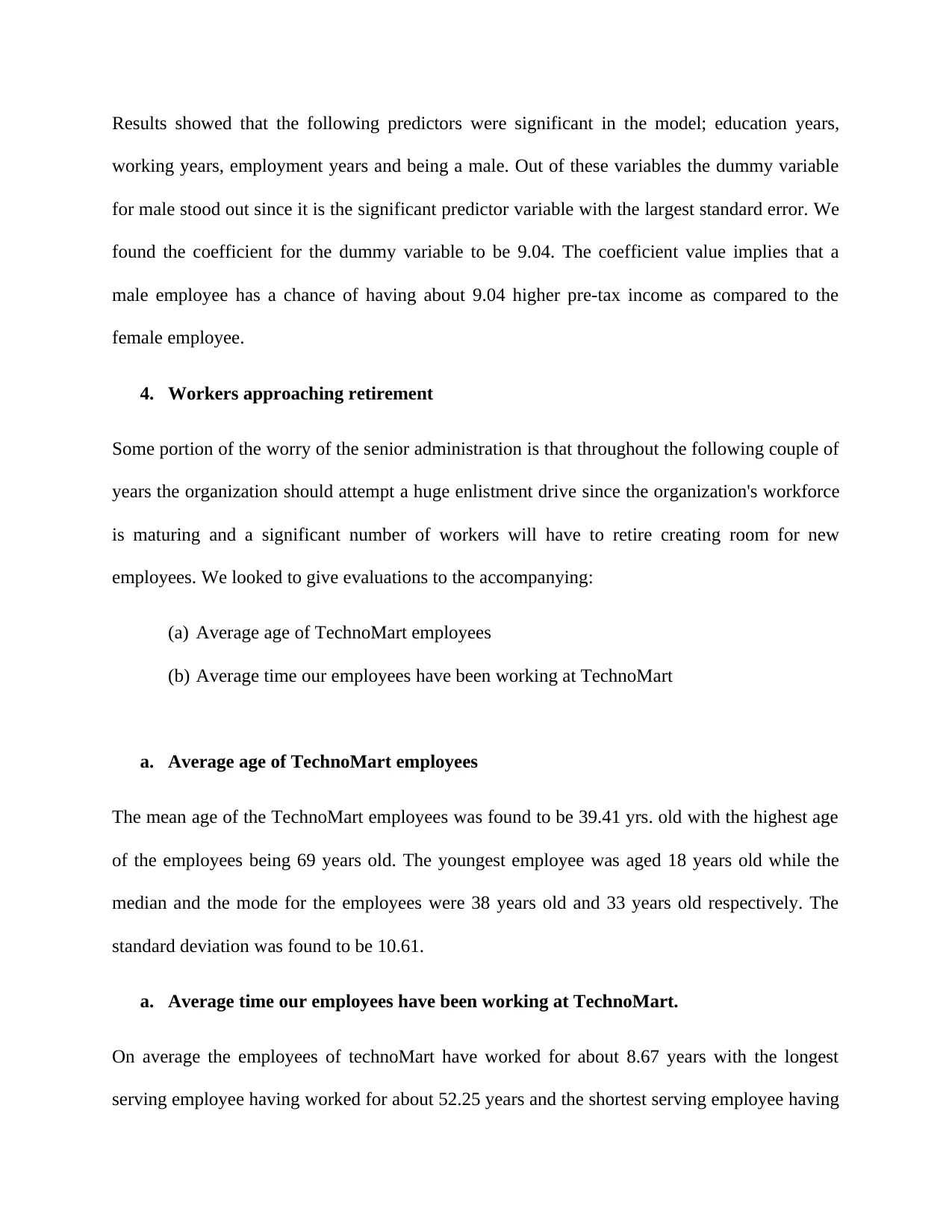
Results showed that the following predictors were significant in the model; education years,
working years, employment years and being a male. Out of these variables the dummy variable
for male stood out since it is the significant predictor variable with the largest standard error. We
found the coefficient for the dummy variable to be 9.04. The coefficient value implies that a
male employee has a chance of having about 9.04 higher pre-tax income as compared to the
female employee.
4. Workers approaching retirement
Some portion of the worry of the senior administration is that throughout the following couple of
years the organization should attempt a huge enlistment drive since the organization's workforce
is maturing and a significant number of workers will have to retire creating room for new
employees. We looked to give evaluations to the accompanying:
(a) Average age of TechnoMart employees
(b) Average time our employees have been working at TechnoMart
a. Average age of TechnoMart employees
The mean age of the TechnoMart employees was found to be 39.41 yrs. old with the highest age
of the employees being 69 years old. The youngest employee was aged 18 years old while the
median and the mode for the employees were 38 years old and 33 years old respectively. The
standard deviation was found to be 10.61.
a. Average time our employees have been working at TechnoMart.
On average the employees of technoMart have worked for about 8.67 years with the longest
serving employee having worked for about 52.25 years and the shortest serving employee having
working years, employment years and being a male. Out of these variables the dummy variable
for male stood out since it is the significant predictor variable with the largest standard error. We
found the coefficient for the dummy variable to be 9.04. The coefficient value implies that a
male employee has a chance of having about 9.04 higher pre-tax income as compared to the
female employee.
4. Workers approaching retirement
Some portion of the worry of the senior administration is that throughout the following couple of
years the organization should attempt a huge enlistment drive since the organization's workforce
is maturing and a significant number of workers will have to retire creating room for new
employees. We looked to give evaluations to the accompanying:
(a) Average age of TechnoMart employees
(b) Average time our employees have been working at TechnoMart
a. Average age of TechnoMart employees
The mean age of the TechnoMart employees was found to be 39.41 yrs. old with the highest age
of the employees being 69 years old. The youngest employee was aged 18 years old while the
median and the mode for the employees were 38 years old and 33 years old respectively. The
standard deviation was found to be 10.61.
a. Average time our employees have been working at TechnoMart.
On average the employees of technoMart have worked for about 8.67 years with the longest
serving employee having worked for about 52.25 years and the shortest serving employee having
⊘ This is a preview!⊘
Do you want full access?
Subscribe today to unlock all pages.

Trusted by 1+ million students worldwide
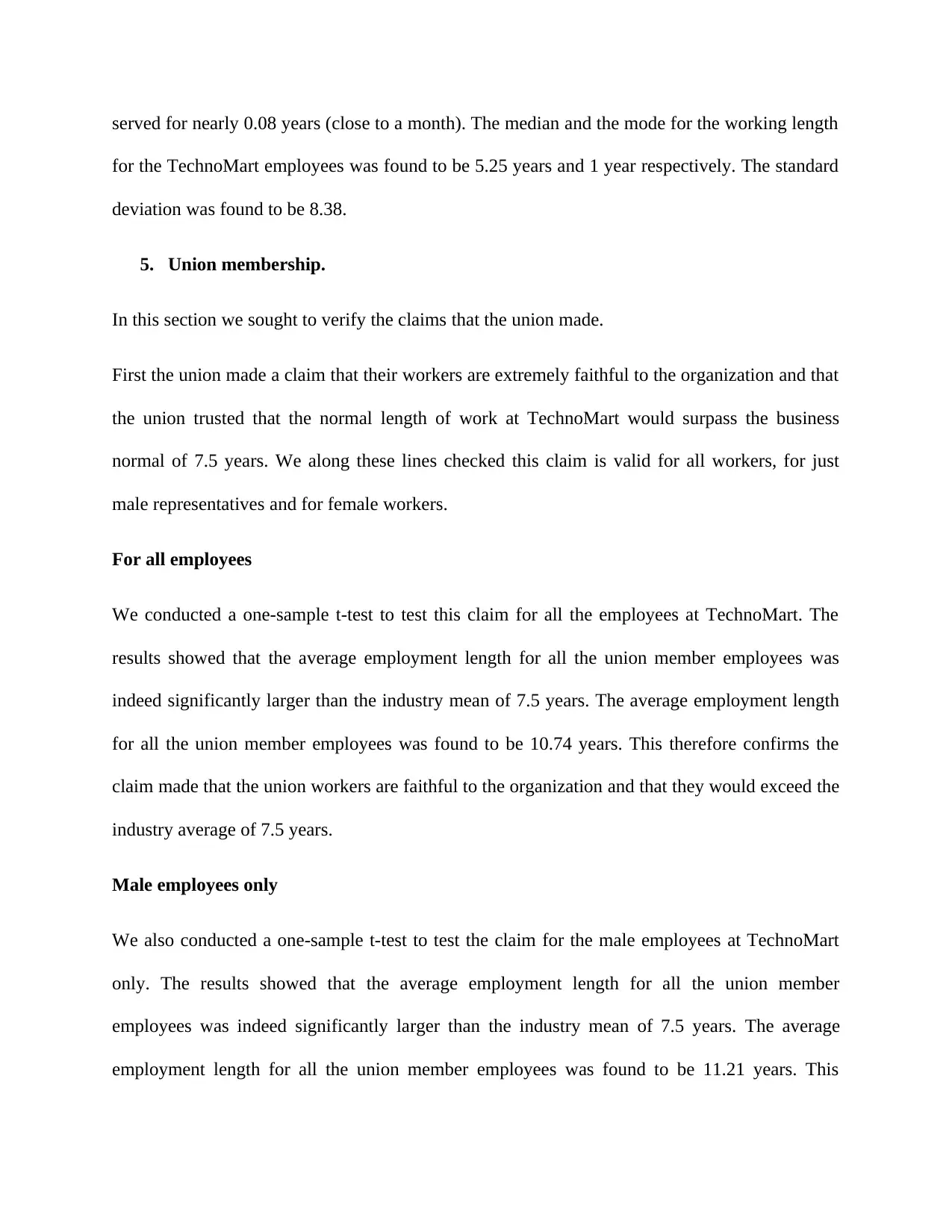
served for nearly 0.08 years (close to a month). The median and the mode for the working length
for the TechnoMart employees was found to be 5.25 years and 1 year respectively. The standard
deviation was found to be 8.38.
5. Union membership.
In this section we sought to verify the claims that the union made.
First the union made a claim that their workers are extremely faithful to the organization and that
the union trusted that the normal length of work at TechnoMart would surpass the business
normal of 7.5 years. We along these lines checked this claim is valid for all workers, for just
male representatives and for female workers.
For all employees
We conducted a one-sample t-test to test this claim for all the employees at TechnoMart. The
results showed that the average employment length for all the union member employees was
indeed significantly larger than the industry mean of 7.5 years. The average employment length
for all the union member employees was found to be 10.74 years. This therefore confirms the
claim made that the union workers are faithful to the organization and that they would exceed the
industry average of 7.5 years.
Male employees only
We also conducted a one-sample t-test to test the claim for the male employees at TechnoMart
only. The results showed that the average employment length for all the union member
employees was indeed significantly larger than the industry mean of 7.5 years. The average
employment length for all the union member employees was found to be 11.21 years. This
for the TechnoMart employees was found to be 5.25 years and 1 year respectively. The standard
deviation was found to be 8.38.
5. Union membership.
In this section we sought to verify the claims that the union made.
First the union made a claim that their workers are extremely faithful to the organization and that
the union trusted that the normal length of work at TechnoMart would surpass the business
normal of 7.5 years. We along these lines checked this claim is valid for all workers, for just
male representatives and for female workers.
For all employees
We conducted a one-sample t-test to test this claim for all the employees at TechnoMart. The
results showed that the average employment length for all the union member employees was
indeed significantly larger than the industry mean of 7.5 years. The average employment length
for all the union member employees was found to be 10.74 years. This therefore confirms the
claim made that the union workers are faithful to the organization and that they would exceed the
industry average of 7.5 years.
Male employees only
We also conducted a one-sample t-test to test the claim for the male employees at TechnoMart
only. The results showed that the average employment length for all the union member
employees was indeed significantly larger than the industry mean of 7.5 years. The average
employment length for all the union member employees was found to be 11.21 years. This
Paraphrase This Document
Need a fresh take? Get an instant paraphrase of this document with our AI Paraphraser
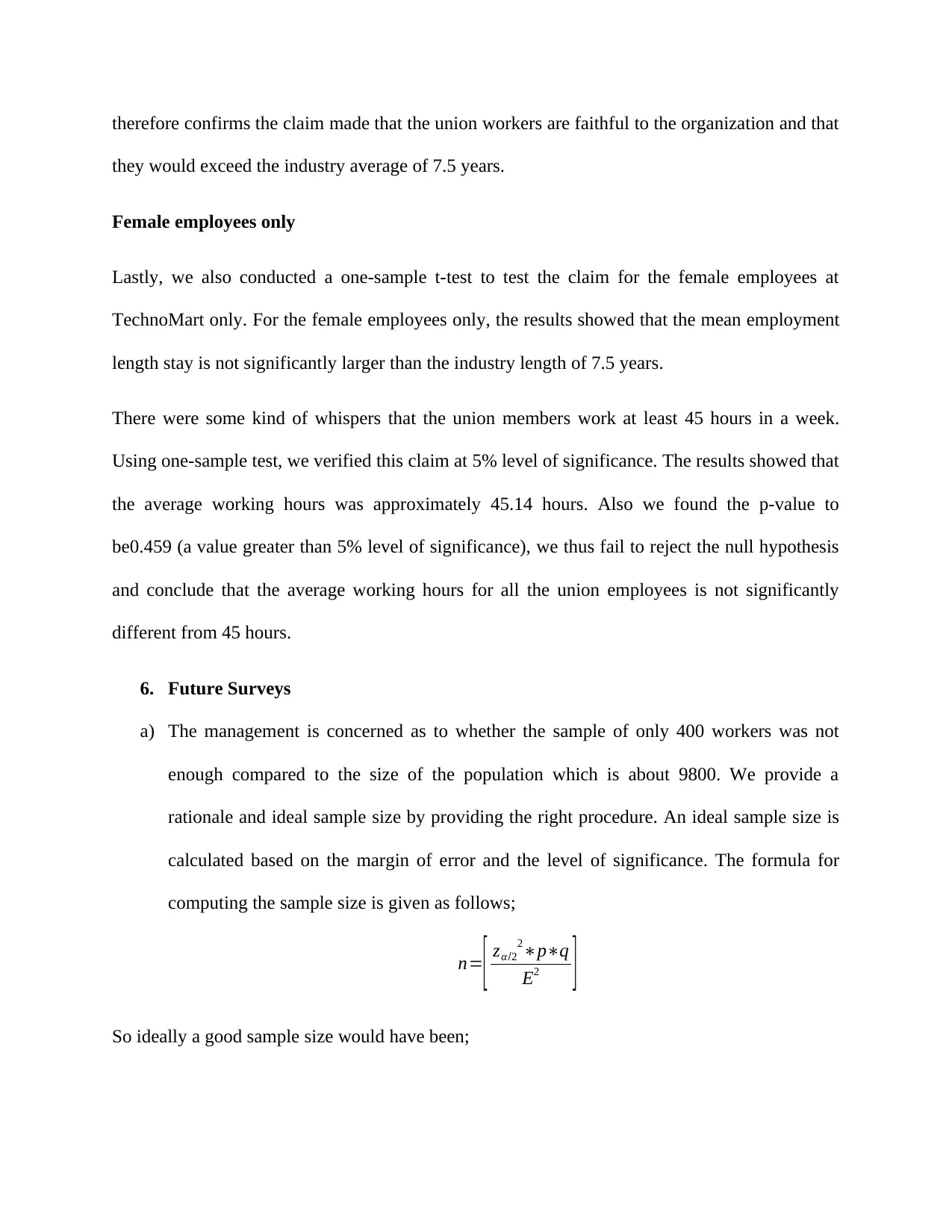
therefore confirms the claim made that the union workers are faithful to the organization and that
they would exceed the industry average of 7.5 years.
Female employees only
Lastly, we also conducted a one-sample t-test to test the claim for the female employees at
TechnoMart only. For the female employees only, the results showed that the mean employment
length stay is not significantly larger than the industry length of 7.5 years.
There were some kind of whispers that the union members work at least 45 hours in a week.
Using one-sample test, we verified this claim at 5% level of significance. The results showed that
the average working hours was approximately 45.14 hours. Also we found the p-value to
be0.459 (a value greater than 5% level of significance), we thus fail to reject the null hypothesis
and conclude that the average working hours for all the union employees is not significantly
different from 45 hours.
6. Future Surveys
a) The management is concerned as to whether the sample of only 400 workers was not
enough compared to the size of the population which is about 9800. We provide a
rationale and ideal sample size by providing the right procedure. An ideal sample size is
calculated based on the margin of error and the level of significance. The formula for
computing the sample size is given as follows;
n=
[ zα/2
2∗p∗q
E2 ]
So ideally a good sample size would have been;
they would exceed the industry average of 7.5 years.
Female employees only
Lastly, we also conducted a one-sample t-test to test the claim for the female employees at
TechnoMart only. For the female employees only, the results showed that the mean employment
length stay is not significantly larger than the industry length of 7.5 years.
There were some kind of whispers that the union members work at least 45 hours in a week.
Using one-sample test, we verified this claim at 5% level of significance. The results showed that
the average working hours was approximately 45.14 hours. Also we found the p-value to
be0.459 (a value greater than 5% level of significance), we thus fail to reject the null hypothesis
and conclude that the average working hours for all the union employees is not significantly
different from 45 hours.
6. Future Surveys
a) The management is concerned as to whether the sample of only 400 workers was not
enough compared to the size of the population which is about 9800. We provide a
rationale and ideal sample size by providing the right procedure. An ideal sample size is
calculated based on the margin of error and the level of significance. The formula for
computing the sample size is given as follows;
n=
[ zα/2
2∗p∗q
E2 ]
So ideally a good sample size would have been;
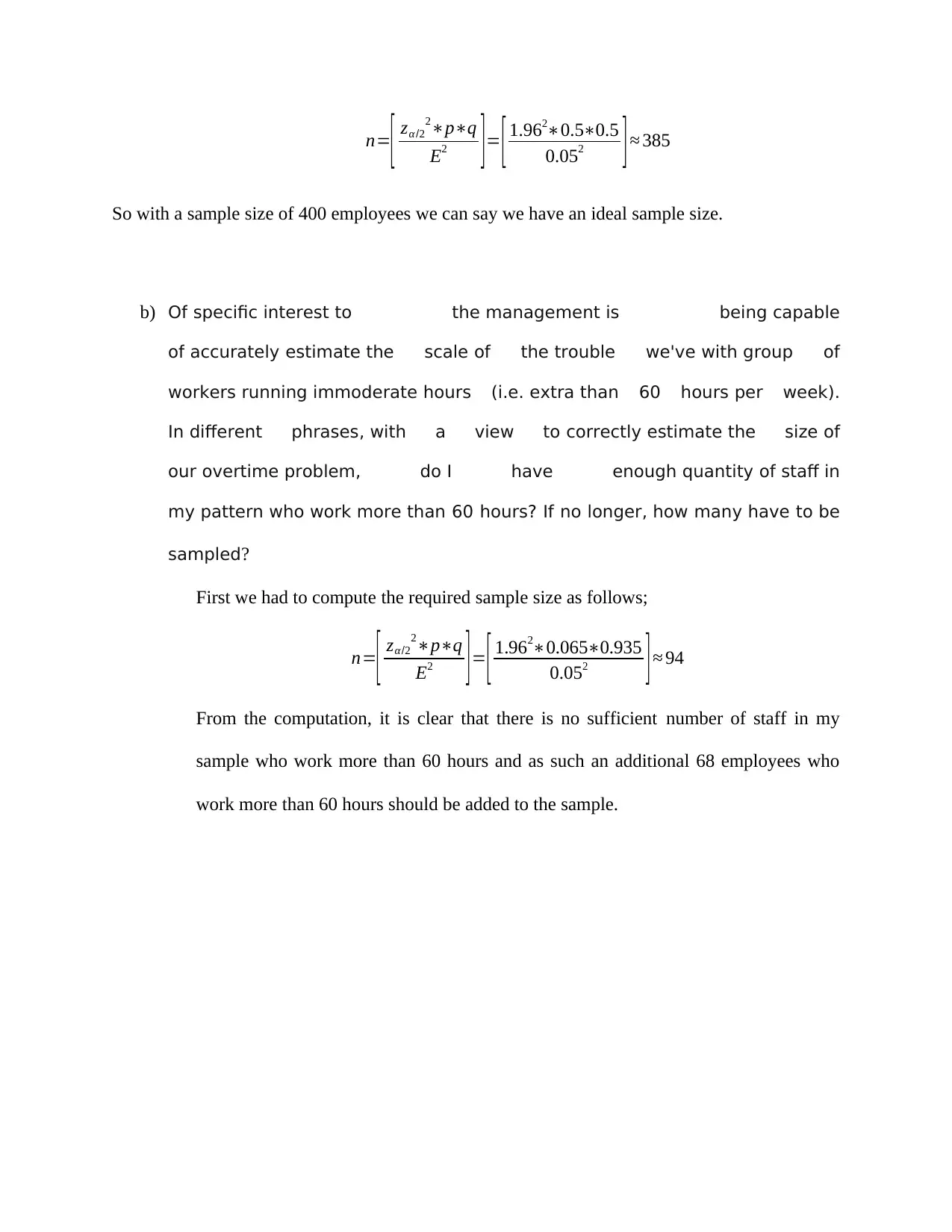
n=
[ zα/2
2∗p∗q
E2 ] = [ 1.962∗0.5∗0.5
0.052 ] ≈ 385
So with a sample size of 400 employees we can say we have an ideal sample size.
b) Of specific interest to the management is being capable
of accurately estimate the scale of the trouble we've with group of
workers running immoderate hours (i.e. extra than 60 hours per week).
In different phrases, with a view to correctly estimate the size of
our overtime problem, do I have enough quantity of staff in
my pattern who work more than 60 hours? If no longer, how many have to be
sampled?
First we had to compute the required sample size as follows;
n=
[ zα/2
2∗p∗q
E2 ] = [ 1.962∗0.065∗0.935
0.052 ] ≈ 94
From the computation, it is clear that there is no sufficient number of staff in my
sample who work more than 60 hours and as such an additional 68 employees who
work more than 60 hours should be added to the sample.
[ zα/2
2∗p∗q
E2 ] = [ 1.962∗0.5∗0.5
0.052 ] ≈ 385
So with a sample size of 400 employees we can say we have an ideal sample size.
b) Of specific interest to the management is being capable
of accurately estimate the scale of the trouble we've with group of
workers running immoderate hours (i.e. extra than 60 hours per week).
In different phrases, with a view to correctly estimate the size of
our overtime problem, do I have enough quantity of staff in
my pattern who work more than 60 hours? If no longer, how many have to be
sampled?
First we had to compute the required sample size as follows;
n=
[ zα/2
2∗p∗q
E2 ] = [ 1.962∗0.065∗0.935
0.052 ] ≈ 94
From the computation, it is clear that there is no sufficient number of staff in my
sample who work more than 60 hours and as such an additional 68 employees who
work more than 60 hours should be added to the sample.
⊘ This is a preview!⊘
Do you want full access?
Subscribe today to unlock all pages.

Trusted by 1+ million students worldwide

1 out of 10
Related Documents
Your All-in-One AI-Powered Toolkit for Academic Success.
+13062052269
info@desklib.com
Available 24*7 on WhatsApp / Email
![[object Object]](/_next/static/media/star-bottom.7253800d.svg)
Unlock your academic potential
Copyright © 2020–2025 A2Z Services. All Rights Reserved. Developed and managed by ZUCOL.




